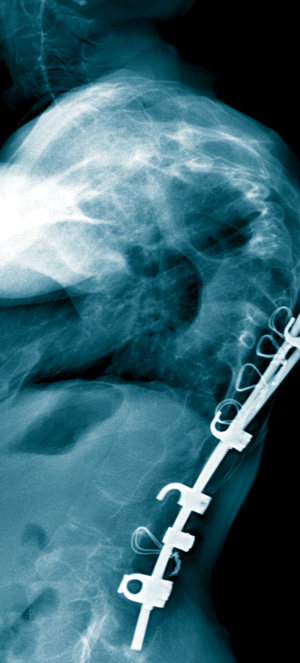Jul. 26, 2013 Research Highlight Medicine / Disease
Connecting the genetic dots on connective tissue disorders
Scientists identify a mutated gene responsible for a spectrum of skeletal and connective tissue disorders
 Figure 1: Spinal x-ray of an SEMDJL1 patient. © 2013 Shiro Ikegawa, RIKEN Center for Integrative Medical Sciences
Figure 1: Spinal x-ray of an SEMDJL1 patient. © 2013 Shiro Ikegawa, RIKEN Center for Integrative Medical Sciences
The disorder known as spondyloepimetaphyseal dysplasia with joint laxity type 1, or SEMD-JL1, is characterized by skeletal abnormalities and loose ligaments that result in spinal misalignment and respiratory problems. The genetic basis of SEMD-JL type 2, a related disorder, was recently determined, but the genetic underpinnings of the type 1 form of the disease remain unknown.
By studying the genomes of seven people with SEMD-JL1, a large international research team led by Shiro Ikegawa from the Laboratory for Bone and Joint Diseases at the RIKEN Center for Integrative Medical Sciences has now identified a gene that, when mutated, is responsible not only for SEMD-JL1 but also a range of other bone and connective tissue defects1.
Noriko Miyake, who joined Ikegawa’s team from Yokohama City University, discovered the gene by sequencing the entire protein-coding region of the genomes of seven Japanese people with SEMD-JL1 from six unrelated families. Using targeted sequencing to confirm initial ‘hits’, Masahiro Nakajima, a member of Ikegawa’s lab, showed that all of the subjects, in addition to an eighth Vietnamese individual with SEMD-JL1, had mutations in a gene called B3GALT6 on the short arm of chromosome 1. This gene codes for a type of enzyme known as a galactosyltransferase II, which is involved in the synthesis of the proteoglycan linker region that helps form the structural cement of connective tissue. The researchers found that mutations in B3GALT6 caused disease in a recessive fashion, meaning that all of the affected individuals had inherited two faulty copies of the gene.
The researchers then noticed that some of the individuals with SEMD-JL1 in the study exhibited many of the same clinical characteristics as those found in people with another connective tissue disorder—the progeroid form of Ehlers-Danlos syndrome, which is characterized by a defect in the synthesis of collagen. To investigate this further, they sequenced the B3GALT6 gene in four people with progeroid-form EDS of unknown genetic cause. All four subjects carried mutations in the B3GALT6 gene.
“B3GALT6 enzyme deficiency results in a wide variety of disorders,” says Ikegawa. “These diseases have been considered to belong to totally different categories of disease, but actually are a spectrum of disorder affecting bone, cartilage, muscle, tendon, ligament and skin. Our findings will enable genetic diagnosis of these diseases.” The researchers anticipate that the findings could open the door to future therapies for disorders related to B3GALT6.
References
- 1. Nakajima, M., Mizumoto, S., Miyake, N., Kogawa, R., Iida, A., Ito, H., Kitoh, H., Hirayama, A., Mitsubuchi, H., Miyazaki, O. et al. Mutations in B3GALT6, which encodes a glycosaminoglycan linker region enzyme, cause a spectrum of skeletal and connective tissue disorders. The American Journal of Human Genetics 92, 927–934 (2013). doi: 10.1016/j.ajhg.2013.04.003
